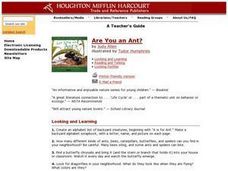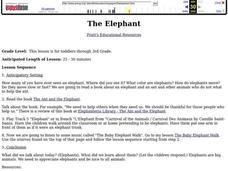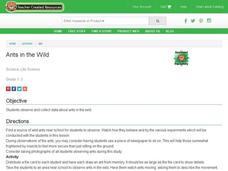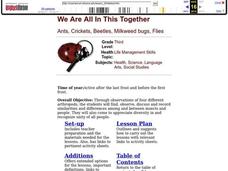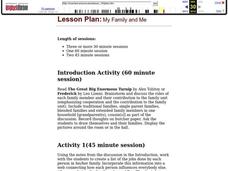Core Knowledge Foundation
Insects Tell It Again!™ Read-Aloud Anthology
A read-aloud anthology explores the world of bees, wasps, beetles, termites, ants, fireflies, and more. Scholars listen to stories and discuss topics and practice word work. Extension opportunities keep the learning going in and out of...
PreKinders
Insect Picture Word Cards
Creepy crawly insects! Learn the names of 12 different insects, including ladybugs, cicadas, and katydids. Each card features a picture of the insect as well as its name in large letters.
PhysEdGames
Dead Ant Tag
Tag, you're a dead ant! Players run around the playing area and runs from the taggers. If a player gets tagged, then they must lay on the ground with their arms and legs in the air. To get back into the game, four people must touch the...
Ask a Biologist
The Many Faces of Ants
Though they be but little, they are fierce! Young biologists read about eight different species of ants, and discover how the anatomy of their heads can explain the way they live and what they eat.
Houghton Mifflin Harcourt
Zombie Ants
One of the creepiest and coolest natural occurrences is a great forum for data analysis and discussion! Explore the phenomenon of zombie ants, or ants infected with the Cordyceps fungus, with a series of activities and experiments. Kids...
Curated OER
The Amazing Ant
Students explain that ants are an important element of nature's balance. Ants eat many insects and are food to other animals. They watch a video and conduct hands-on activities that give them an excellent overview of the ants role in...
Curated OER
Ants
Ants are a common example to use when conducting lessons on insects, and if your youngsters are squeamish, this is a way to introduce them without actually bringing them into the classroom! Viewers of this PowerPoint learn about the...
Curated OER
When Ants Fly
Here is a great lesson on constructing line graphs. Learners identify common characteristics of birds, ants common needs of all living things. They also write a story from the perspective of an ant or a bird that has lost its home and...
Curated OER
Did You Know?
Learn about ants and printing in one fun worksheet! After you read some interesting facts about ants, practice writing the word ant on a tracing line. Then, draw a picture of an ant in a space provided.
Curated OER
Buoyant Behavior
Combine science and literature with this instructional activity on buoyancy. Read There's an Ant in Anthony by Bernard Most to examine words containing the letters a, n, and t. Then introduce your class to the word "buoyant." Demonstrate...
Curated OER
Are You an Ant?
Young scholars investigate different insects in their backyard. In this insect lesson, students read the book Are You and Ant? and apply the reading to their backyards. Young scholars create a list of animals that begin with the the...
Curated OER
The Elephant
Students listen to a story about helping others. In this citizenship lesson plan, students investigate a group of animals that do not want to help an ant. Students learn about elephants and sing songs about the elelphant in story.
Curated OER
Ants in the Wild
Students investigate ants in the wild. In this insect lesson, students observe ant colonies and conduct experiments, such as putting food in the ants' path. Students record their observations.
Curated OER
Bugs Worksheet - What Bugs Do
In this bug themed worksheet, learners will examine seven bugs and seven descriptions and then determine which bug matches each description.
Curated OER
Insects: Bug Off
Learners design and conduct an experiment to test three organic pesticides to control ants. They view a video that demonstrates ant behavior and the role of pesticides in insect control. In small groups, they set up behavior...
Curated OER
Ant Arcitecture
Students create pages of a classroom book on the different structures that ants build. They view and discuss a video on ants then, in small groups, research a type of ant shelter. They relate the shelter to the environment in which the...
Curated OER
Ants
Learners make sequential patterns by using ants and following the model. They identify different parts of an ant by matching the picture to the word name. Pupils identify the ant's life cycle by creating a chart using pictures.
Curated OER
Take an Ant to Lunch
Second graders construct a model of an ant, exemplifying that ants are insects. Students gather data create a pictograph chart to show ant food preferences. Also, 2nd graders access the Internet to explore ant eating habits.
Curated OER
Ants
Third graders study the habits and habitats of ants. They research the use of technology as a valuable investigation tool and access other web sites for future research projects. The students make successful decisions while playing SimAnt.
Curated OER
The Queen's Empire
Students conduct Internet research on a variety of ant species and their habitats. They have an opportunity to observe ants in their environment. Areas of interest might include ant identification, colony life, the ant life cycle, and...
Curated OER
The Behavior of Ants
Students use the steps of the Scientific Method to develop and test their own ideas through experimentation with ants.
Curated OER
We Are All In This Together
Third graders observe four different arthropods.Students find, observe, discuss and record similarities and differences among and between insects and people. They appreciate diversity in and recognize unity of all people.
Curated OER
Counting Objects
In this counting objects learning exercise, students count the number of animals in one problems and ants in another problem. Students complete 2 problems total.
Curated OER
My Family and Me
Students discuss the family unit and compare it to an ant colony. In this family lesson, students draw their family and extended family and talk about their jobs and family roles. They compare this to an ant colony and observe the work...












